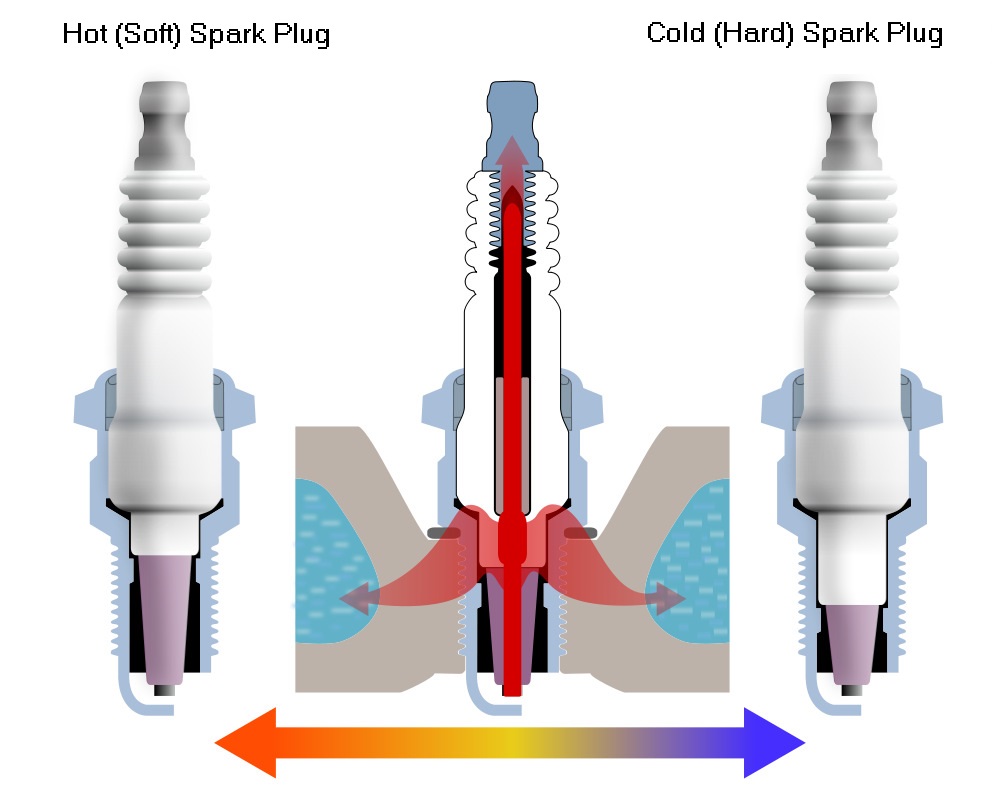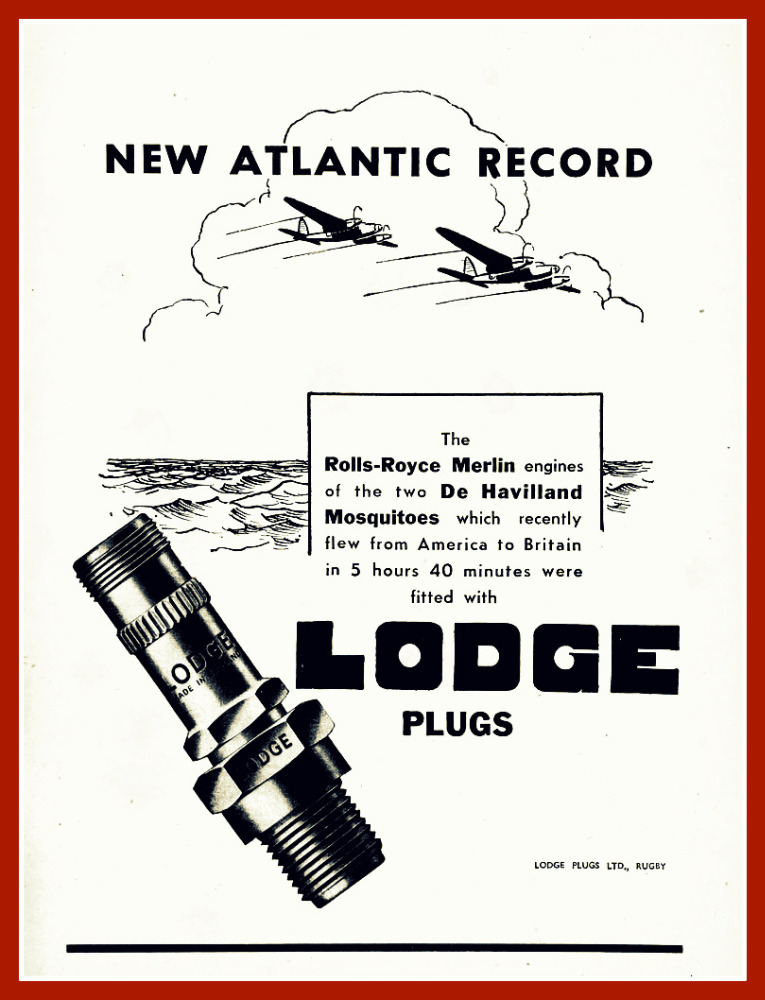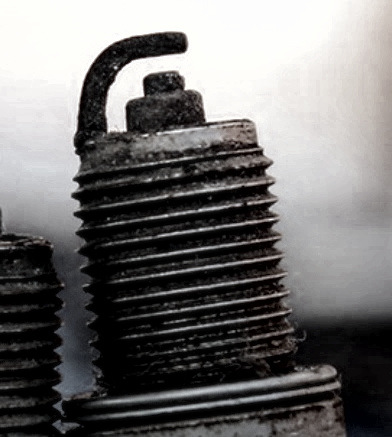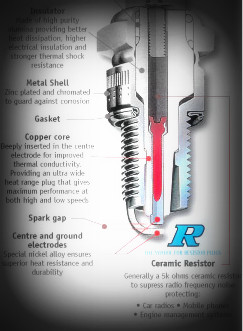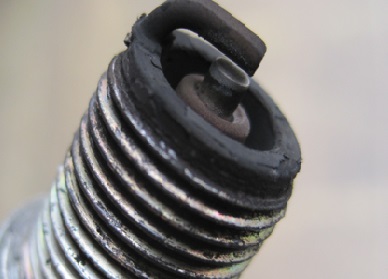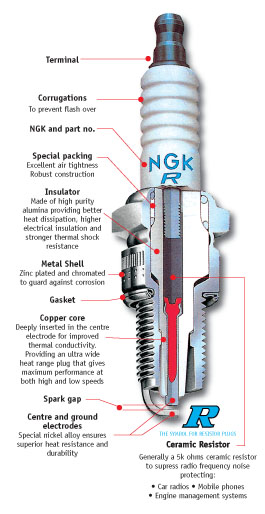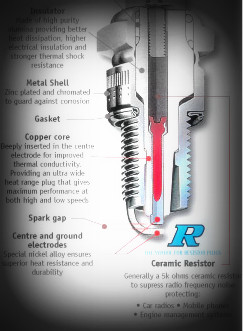A place for things that don't fit into the automotive world
Spark Plug
- Andy.MacFadyen
-
 Topic Author
Topic Author
- Offline
- Moderator
-

Less
More
- Posts: 3353
- Thank you received: 1037
8 years 5 months ago - 8 years 5 months ago #11328
by Andy.MacFadyen
" We're trying to plug a hole in the universe, what are you doing ?. "
(Walter Bishop Fringe TV show)
Spark Plug was created by Andy.MacFadyen
Before internal combustion engines had electrical they had "Hot Bulb or Hot tube ignition" which use a tube extension to the combustion chamber heated by blow lamp which heated the end of the tube to red heat, not unlike like a glow plug model aircraft engine. Think of it as pre-ignition in action.
When electric ignition came along in the form of trembler coils and magnetos the spark plug was invented. Pre-WW1 spark plugs used stacked mica disks as insulators.
Images from Wiki Commons link
Fully ceramic insulators were developed all these early spark plugs could be dismantled for cleaning this is a Model T Ford spark plug.
In the 1930's the swaged constructionwe are used to became the norm.
When electric ignition came along in the form of trembler coils and magnetos the spark plug was invented. Pre-WW1 spark plugs used stacked mica disks as insulators.
Images from Wiki Commons link
Fully ceramic insulators were developed all these early spark plugs could be dismantled for cleaning this is a Model T Ford spark plug.
In the 1930's the swaged constructionwe are used to became the norm.
" We're trying to plug a hole in the universe, what are you doing ?. "
(Walter Bishop Fringe TV show)
Last edit: 8 years 5 months ago by Andy.MacFadyen.
Please Log in or Create an account to join the conversation.
- Andy.MacFadyen
-
 Topic Author
Topic Author
- Offline
- Moderator
-

Less
More
- Posts: 3353
- Thank you received: 1037
8 years 5 months ago - 8 years 5 months ago #11329
by Andy.MacFadyen
" We're trying to plug a hole in the universe, what are you doing ?. "
(Walter Bishop Fringe TV show)
Replied by Andy.MacFadyen on topic Spark Plug
Heat range: All these early spark plugs had a limmited heat range which caused problems with either cold fouling or plug overheating.
To resist cold fouling and avoid overheating the tip of the spark plug should run a temperature between 450 and 800c
Hot spark plugs resist cold fouling but risk plug over heating and pre-ignition Cold spark plugs run cooler. Manufacturers produce a wide "heat range" of spark plugs to produce the most suitable plug for any engine.
Cold fouling was a real problem often spark plug manuafacturers would list two different spark plugs for town and normal use, as late as the 1970's Champion for the Mercedes fintail 190 and 200 listed the N6Y plug for normal use and the hotter N9Y for town centre or taxi use.
Back in the old days before electronic fuel injection, and high energy ignition systems pre-1960's it was not uncommon for racing car and bike engines to be started on hot spark plugs which were changed for cold plugs before going out on track. Racing mechanics traditionally called Hotter spark plugs "Soft" and Colder rated plugs "Hard".
This image is from the NGK Website
The difference between a hot plug and a colder plug is the amount of ceramic core exposed to hot combustion gasses and area of heat path available to conduct heat way from the core.
To resist cold fouling and avoid overheating the tip of the spark plug should run a temperature between 450 and 800c
Hot spark plugs resist cold fouling but risk plug over heating and pre-ignition Cold spark plugs run cooler. Manufacturers produce a wide "heat range" of spark plugs to produce the most suitable plug for any engine.
Cold fouling was a real problem often spark plug manuafacturers would list two different spark plugs for town and normal use, as late as the 1970's Champion for the Mercedes fintail 190 and 200 listed the N6Y plug for normal use and the hotter N9Y for town centre or taxi use.
Back in the old days before electronic fuel injection, and high energy ignition systems pre-1960's it was not uncommon for racing car and bike engines to be started on hot spark plugs which were changed for cold plugs before going out on track. Racing mechanics traditionally called Hotter spark plugs "Soft" and Colder rated plugs "Hard".
This image is from the NGK Website
The difference between a hot plug and a colder plug is the amount of ceramic core exposed to hot combustion gasses and area of heat path available to conduct heat way from the core.
" We're trying to plug a hole in the universe, what are you doing ?. "
(Walter Bishop Fringe TV show)
Last edit: 8 years 5 months ago by Andy.MacFadyen.
The following user(s) said Thank You: Noah
Please Log in or Create an account to join the conversation.
- Andy.MacFadyen
-
 Topic Author
Topic Author
- Offline
- Moderator
-

Less
More
- Posts: 3353
- Thank you received: 1037
8 years 5 months ago #11341
by Andy.MacFadyen
" We're trying to plug a hole in the universe, what are you doing ?. "
(Walter Bishop Fringe TV show)
Replied by Andy.MacFadyen on topic Spark Plug
In the years up to WW2 organic lead started to be used as an octan booster in fuels and compression ratios were increased to take advantage of these new fuels. The Model T Ford had a compression ratio of 4.5:1 (4.25:1 on some models) by the mid 1930's on a typical engine would use a 6.5:1 . The lead in the gasoline caused the powdery deposits on the nose of the spark plug , with normal pump gasoline these deposits had little or no effect on the operation of the spark plug but could be a problem on piston aero engines which were running highly leaded 110 octane fuel towards the end of WW2, this triggered the first introduction of platinum tipped spark plugs. These very expensive Lodge plugs were also used in tanks and other military vehicles and motot torpedo boats.
" We're trying to plug a hole in the universe, what are you doing ?. "
(Walter Bishop Fringe TV show)
Please Log in or Create an account to join the conversation.
- Andy.MacFadyen
-
 Topic Author
Topic Author
- Offline
- Moderator
-

Less
More
- Posts: 3353
- Thank you received: 1037
8 years 5 months ago - 8 years 5 months ago #11347
by Andy.MacFadyen
" We're trying to plug a hole in the universe, what are you doing ?. "
(Walter Bishop Fringe TV show)
Replied by Andy.MacFadyen on topic Spark Plug
Although these platinium tipped plugs were a major asdvance at this point they were too expensive for the mass market, two major developments one introduced by Champion the other by NGK would improve a spark plugs resistance to both cold fouling and over heating and expand the heat range that could be covered by a given plug type.
In the early 1960's Champion first marketed spark plugs with a extended nose core,. The tip this style of spark plug reaches running temperature quickly but air from the inlet valve flows over the tip of the spark plug during the induction stroke and prevents it reaching damagingly high temperatures.
This is the business end of a champion N9Y one of the first projecting nose spark plugs to reach the market, with Champion spark plugs the Y suffix on the type number indicates a projecting nose type
Compare the nose of the plug with the picture below a Champion N5 the spark plug it replaced in a lot of european car applications
In the early 1960's Champion first marketed spark plugs with a extended nose core,. The tip this style of spark plug reaches running temperature quickly but air from the inlet valve flows over the tip of the spark plug during the induction stroke and prevents it reaching damagingly high temperatures.
This is the business end of a champion N9Y one of the first projecting nose spark plugs to reach the market, with Champion spark plugs the Y suffix on the type number indicates a projecting nose type
Compare the nose of the plug with the picture below a Champion N5 the spark plug it replaced in a lot of european car applications
" We're trying to plug a hole in the universe, what are you doing ?. "
(Walter Bishop Fringe TV show)
Last edit: 8 years 5 months ago by Andy.MacFadyen.
Please Log in or Create an account to join the conversation.
- Andy.MacFadyen
-
 Topic Author
Topic Author
- Offline
- Moderator
-

Less
More
- Posts: 3353
- Thank you received: 1037
8 years 5 months ago - 8 years 5 months ago #11351
by Andy.MacFadyen
" We're trying to plug a hole in the universe, what are you doing ?. "
(Walter Bishop Fringe TV show)
Replied by Andy.MacFadyen on topic Spark Plug
NGK took a different approach to the same problem they introduced the Copper Core On a copper core plug the centre electrode is built around a copper inner rod the acts as a heat sink to remove heat from the nose of the plug, effectively allowing a hotter (softer) heat range plug to be use without it over heating.
Thaking a que from Japanese motor cycles these plugs were much in demand for car racing in the 1970s. Champion and Bosch had no equivalent at the time.
Thaking a que from Japanese motor cycles these plugs were much in demand for car racing in the 1970s. Champion and Bosch had no equivalent at the time.
" We're trying to plug a hole in the universe, what are you doing ?. "
(Walter Bishop Fringe TV show)
Last edit: 8 years 5 months ago by Andy.MacFadyen.
Please Log in or Create an account to join the conversation.
- Andy.MacFadyen
-
 Topic Author
Topic Author
- Offline
- Moderator
-

Less
More
- Posts: 3353
- Thank you received: 1037
8 years 5 months ago - 8 years 5 months ago #11364
by Andy.MacFadyen
" We're trying to plug a hole in the universe, what are you doing ?. "
(Walter Bishop Fringe TV show)
Replied by Andy.MacFadyen on topic Spark Plug
At the start of the 1990's car manufacturers were looking for ways to extend service intervals, this required finding away to extend the life of spark plugs. One of the methods used was to revamp a 1920's idea and use spark plugs with multiple side electrodes. With this type of plug although there are between two and four side electrodes only a single spark will jump (always from the side electrode with the narrowest gap to central electrode) on each ignition event
.
.
" We're trying to plug a hole in the universe, what are you doing ?. "
(Walter Bishop Fringe TV show)
Last edit: 8 years 5 months ago by Andy.MacFadyen.
The following user(s) said Thank You: Noah
Please Log in or Create an account to join the conversation.
- Andy.MacFadyen
-
 Topic Author
Topic Author
- Offline
- Moderator
-

Less
More
- Posts: 3353
- Thank you received: 1037
8 years 5 months ago - 8 years 5 months ago #11401
by Andy.MacFadyen
" We're trying to plug a hole in the universe, what are you doing ?. "
(Walter Bishop Fringe TV show)
Replied by Andy.MacFadyen on topic Spark Plug
The high tension coil and breaker points ignition system was invented by Charles Kettering for Chevrolet just after WW1. Some of us old enough to have replaced ignition contact breaker points will remember these 1960s Delco ones which had to be replaced every 5,000 to 6,000 miles. Gaping contact points correctly was some of an art as you had not only to set the gap correctly but learn to allow for worn distributors and some types for example on Fords where the gap would close up after the first few miles running. If the contact breaker gap ( between 0.012" and 0.035" depending on type) was set wrongly the ignition timing and dwell angle would be out of specfication.
For forum members lucky enough to be too young to remember contact breaker distributors this link has more details. Link to Simonlacy.com
In the late 1960's Emission restrictions placed new demands on ignition systems, higher spark engery was needed to reliably ignite leaner mixtures combined with extended service intervals. Electronic ignition systems had been around since the late 1950s, the early systems still retained contact breaker points and offered little or no advantage over the original 1920' Kettering sysem. The first real improvement came the contact breaker was replaced by an electronic sensor, In the late 1970's the volume car makers started to move to electronic ignition retaining a conventional distributer with old style centrifugal and vacuum advance. Most of these early system weren't much more reliable than contact breaker ignition but that gradually changed, what they did provide was a high energy spark resulting a reduction in misfires and and easier starting.
For forum members lucky enough to be too young to remember contact breaker distributors this link has more details. Link to Simonlacy.com
In the late 1960's Emission restrictions placed new demands on ignition systems, higher spark engery was needed to reliably ignite leaner mixtures combined with extended service intervals. Electronic ignition systems had been around since the late 1950s, the early systems still retained contact breaker points and offered little or no advantage over the original 1920' Kettering sysem. The first real improvement came the contact breaker was replaced by an electronic sensor, In the late 1970's the volume car makers started to move to electronic ignition retaining a conventional distributer with old style centrifugal and vacuum advance. Most of these early system weren't much more reliable than contact breaker ignition but that gradually changed, what they did provide was a high energy spark resulting a reduction in misfires and and easier starting.
" We're trying to plug a hole in the universe, what are you doing ?. "
(Walter Bishop Fringe TV show)
Last edit: 8 years 5 months ago by Andy.MacFadyen.
The following user(s) said Thank You: Noah
Please Log in or Create an account to join the conversation.
Time to create page: 0.370 seconds






